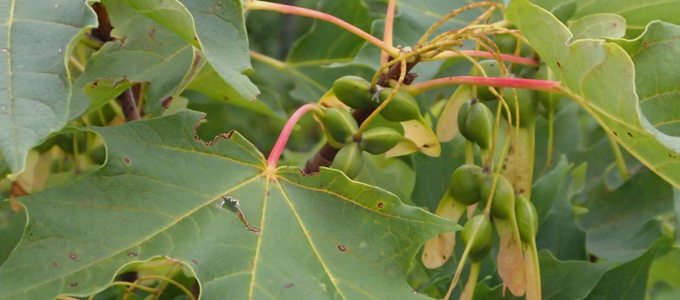One particularly interesting life-history strategy is masting, the episodic and synchronous production of seeds over large geographic areas. Masting is hypothesized to improve fitness via economies of scale, for instance through improved pollination, dispersal, and/or seed survival in mast years. These fitness benefits are observed in many species, but the proximate drivers of masting are less well understood. I am using sugar maple as a study system to understand the relationship between seed production and endogenous resource dynamics in trees, how these resource dynamics affect other plant functions and forest productivity, and how ecological drivers of productivity influence the harvest of a forest product (maple syrup) and its associated economy. Sugar maple is an excellent study system for investigating the ecology of seed production and the influence of life-history on forest productivity and economics because:
- Resource dynamics and reproductive investment vary from year to year
- Sap and syrup production records provide long term records of carbohydrate reserves
- Interest in the species’ performance under climate change is high because of its’ economic and cultural importance.
To understand the ecological dynamics of masting, I am using experimental studies at Harvard Forest to link the physiology of resource gain (photosynthesis, carbohydrates, nutrients, growth) to reproductive effort (flowering and seed production). This research is motivated by theory. The Resource Budget Model (RBM) of masting posits that a resource storage threshold controls when individual plants flower. When the threshold is exceeded, plants flower, and if flowers are pollinated, abundant seed production depletes resources and it takes multiple years for plants to store enough resources to again flower. Under the RBM, flowering can be synchronized among plants by pollen coupling or environmental variability that limits reproduction in some years. Pollen coupling occurs when pollen limitation in low flowering years prevents seed maturation. Plants that flower but don’t set seed in these years don’t deplete resources and keep flowering until the next mast year, when they become entrained with the rest of the population. Environmental conditions that limit reproduction, such as frost or drought, can act similarly in that plants that are prevented from setting seed are more likely to flower in the next year. My research at Harvard Forest has revealed tradeoffs with reproduction of carbon gain and allocation at the twig level, and resource-driven patterns of flowering and fruiting at the tree level. The amount of sugar collected from sap is lower following mast years, suggesting that masting depletes the resource stores which also provision sap sugar. Similarly, using data on maple syrup production from the USDA and seed production from the Vermont Monitoring Cooperative, I’ve shown that maple syrup production declines after mast years at the state-scale in Vermont. This research has the potential to greatly improve sugar-season forecasts for maple syrup producers.
Collaborator
Elizabeth Crone, Tufts University, Department of Biology
